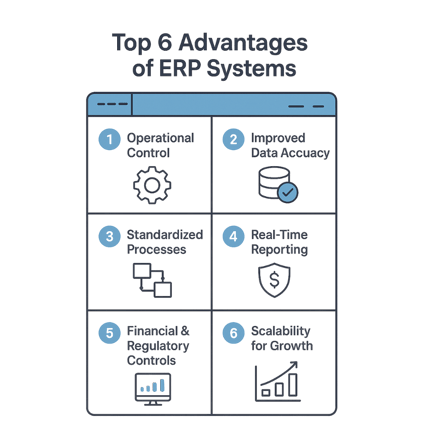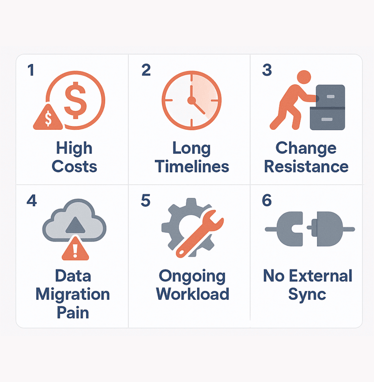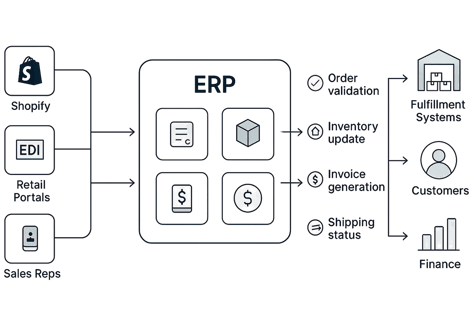On this page
Subscribe for updates
Keep up with OrderEase and access industry-leading order operation insights.
ERP Systems Promise a Lot, But Do They Deliver?
ERP (Enterprise Resource Planning) helps companies consolidate their business in a single software system. Instead of multiple systems for HR, finance, and sales, ERPs eliminate the disconnect for unified operations.
Still, the advantages of ERPs don’t necessarily outweigh the disadvantages.
.png?width=560&height=373&name=erp%20systems%20pro%20and%20cons%20(1).png)
ERPs can be expensive, and they require clean data for the investment to be worth it. Too often, companies experience slow adoption, and processes remain disconnected. Ultimately, the ROI isn’t there.
So the question is fair:
Is ERP worth the investment, time, and transformation it requires?
This article explores both sides. We’ll break down the real advantages and disadvantages of ERP systems, explain where and why they succeed or fall short, and show how an ERP integration strategy is often the factor that makes or breaks ERP success.
What is an ERP System?
First, let’s define what an ERP is. For organizations using accounting software amidst of high-growth, an ERP is often the next step. ERPs are made up of modules that are used by different teams throughout a company. It means that data from sales is easily accessible by finance or fulfillment teams.
Here’s some common modules:

ERP in Action: A Real Example
Scenario: A wholesale distributor receives a large order from a retail chain.
- Sales: Order is placed via an EDI portal, then copied and rekeyed into the ERP
- Inventory: The team checks the ERP for stock availability
- Procurement: If inventory is low, the team generates a PO
- Warehouse: Pick/pack lists are generated, and shipping labels are printed
- Finance: Invoice is sent based on customer terms
All of this is done without jumping between systems.

Why ERP Systems Outperform Traditional Accounting Software
When businesses start to scale, they find tension in their accounting systems. Most are built for SMB (small-medium businesses), and leave operations in silos where teams chase each other down for critical business data.
Accounting systems are great for financial reporting and tracking expenses, but they’re not designed for larger organizations.
Example limitations:
- Can’t manage inventory levels in multiple warehouses
- Can’t track production or bill of materials
- Requires manual work or add-ons to connect with your CRM, eCommerce, or fulfillment
Instead of stitching together tools for different teams, an ERP brings it all together.
Why ERP Is Critical in Modern B2B Business
Today’s B2B companies face increased pressure with fast-moving markets and rising expectations for speed.
When properly integrated, ERP brings consistency to business operations. It replaces siloed systems with shared workflows, disconnected data with a single source of truth, and reactive decision-making with real-time insight.
The Advantages of ERP Systems
ERP systems are built to solve one of the most persistent challenges in growing businesses: silos across departments. As companies grow, they end up juggling a growing list of disconnected tools, and ERP aims to eliminate that sprawl. At its core, an ERP system offers a single platform that supports the core functions of your business.
Here's what that unlocks:

1. Operational Control
ERP systems provide business functions like finance, inventory, procurement, manufacturing, HR, and more, all in a single environment. Without an ERP, manual workflows slow down business operations and significantly limit scalability.
The advantage of an ERP is that instead of manually reconciling data between two different accounting and purchasing systems, ERP ensures that things like a purchase order, goods receipt, and invoice approval are part of the same process.
Gartner highlights that “done right, ERP provides the organization with unrivaled visibility into and control of current operations”.
2. Improved Data Accuracy and Consistency
One of the biggest operational risks in any growing business is working with the wrong data. When inventory is in one system, pricing in another, and financials elsewhere, it’s easy for teams to act on incorrect information.
ERPs act as a single source of truth. With operations all under one roof, data is inherently synchronized.
This improves not just accuracy, but confidence. Teams make decisions knowing they’re working with the right information.
3. Standardized Business Processes
Every department and every empoyee develops their own way of doing things. That flexibility may work early on, but it introduces risk and operational chaos at scale.
The benefit of Enterrise Resource Planning Software is standardized workflows across the organization. Whether you're issuing a purchase order or onboarding a new employee, the process follows predefined steps.
4. Real-Time Reporting and Visibility
ERP systems provide powerful reporting and analytics tools that pull directly from your business data. This allows for real-time insight into things like:
- Cash flow and profitability
- Inventory turnover
- Order statuses and fulfillment rates
- Budget vs. actual spend across departments
Instead of reconciling multiple exports and assessing raw data, you get a live dashboard view of your business’s health.
5. Built-In Financial and Regulatory Controls
Finance isn’t just about balancing books, it’s about enforcing financial discipline. ERP systems provide controls into everyday workflows.
For example:
- Approval hierarchies can be applied to POs or expense reports
- Tax rules and multi-currency support can be built into invoicing logic
6. Scalable Foundation for Business Growth
SMBs using entry-level, disconnected tools will inevitably outgrow them as they achieve growth. What works for a $5M company quickly breaks down at $25M or $50M.
ERP systems are designed to scale with complexity, not collapse under it. They support:
- Multi-entity or global financial consolidation
- Role-based access control and audit trails
- Expansion into new business units, product lines, or geographies
Because ERP consolidates so much of your core infrastructure, it becomes the platform you grow on, not around.
A Recap on the Benefits of Enterprise Resource Planning Software:
ERP systems can provide structure operational leverage. They bring the entire business onto a shared system for better decision-making, reducing the friction that slows down growth.
Integration matters for the full advantage of ERPs to be realized, but ERP on its own is a powerful step toward a scalable organization.
The Disadvantages of ERP Systems
ERP systems are powerful but before they unlock operational efficiency, they often introduce cost, risk, and complexity.
Below are the disadvantages of ERP systems as standalone platforms, based on what operations leaders encounter in the real world.

1. High Upfront Costs With Deferred ROI
An ERP isn’t a small investment. A common disadvantages of ERP systems is costs surpassing tens of thousands of dollars in:
- Software licenses
- Implementation services
- Customization and workflow configuration
- Data migration and testing
- Training and change management
These costs are front-loaded. You pay early, but the return comes years later.
For teams used to low-overhead tools like QuickBooks or spreadsheets, ERP feels like a budget shock. And ROI timelines are a significant risk.
2. Lengthy and Resource-Heavy Implementations
ERP systems unify everything including; finance, operations, sales, inventory, procurement, fulfillment, and HR. That interconnectedness is an advantage of ERPs, but it comes with long, complex implementation timelines.
Rollouts often take 6–18 months, especially if:
- You’re deploying multiple modules at once
- Your existing processes need to be redesigned
- Your data is disorganized or inconsistent
- You have limited internal resources to support the project
ERP isn’t just software, it’s an organizational transformation. Delays come not from coordination breakdowns and lack of decision-making clarity.
3. Change Management Is Underestimated
ERP success depends on people, not just software.
Without alignment across teams, even the best ERP will fail. Users fall back on workarounds that erode data quality (and ROI).
Common challenges:
- Resistance to added process
- Decreased productivity during the learning curve
- Departmental friction when workflows are centralized
ERP forces standardization, but that means change. The disadvantage of ERP is where change leads to adoption failure. Leadership often underestimates the emotional and cultural shift involved.
4. Data Migration Is a Costly and Risk-Prone Process
ERP demands clean, structured, standardized data, but most businesses underestimate how disorganized their data quality truly is.
For example, many $5-$15M ARR manufacturers experience:
- Inconsistent SKUs and naming conventions
- Duplicate or outdated customer/vendor records
- Disconnected systems with conflicting data sources
- Pricing rules embedded in emails, spreadsheets, or people’s heads
Migrating this into ERP isn’t just about importing a CSV. It requires:
- Data cleansing
- Standardization
- Mapping legacy processes
- Testing and re-testing for accuracy
ERP migration can slow adoption, forcing expensive rework after go-live.
5. Ongoing System Ownership Requires Real Resources
ERP isn’t just a one-time implementation. You’ll need ongoing effort to:
- Configure new workflows or modules
- Maintain user roles and security
- Manage software updates
- Support business changes
- Troubleshoot errors and edge cases
Having an ERP means the financial investment goes beyond the subscription. You’ll need a full time employee to maintain it, or a consultant to work on it consistently.
6. ERP Alone Doesn’t Eliminate System Silos
While ERP centralizes business functions, it doesn’t connect to the rest of your tech stack.
For example, a company selling B2B ecommerce would still have to:
- Manually import orders from Shopify or reps, copying data from each channel to their ERP
- Export inventory to fulfillment platforms like ShipWise
- Sync invoices between ERP and billing tools
- Reconcile orders from external systems like EDI or portals
A Recap of ERP Drawbacks
|
Disadvantage |
Why It Matters |
|
High costs |
ROI takes time and careful scoping |
|
Long timelines |
Disruption if not managed carefully |
|
Change resistance |
People need to adapt |
|
Data migration pain |
Bad data = bad outcomes |
|
Ongoing workload |
ERP needs continuous ownership |
|
No external sync |
ERP alone doesn’t eliminate manual effort |
Why Integration Is the Key to ERP Success
ERP systems are designed to centralize your business, but centralization doesn’t equal orchestration.
Without integration, even the best ERPs function in isolation from the way channels, customers, and fulfillment networks actually operate. Teams are left importing spreadsheets, logging into multiple portals, chasing order status updates, and reconciling data manually.
Integration turns ERP into a system of action.
%20versus%20ERP%20with%20integration%20(automated%20sync%2c%20real-time%20updates%2c%20end-to-end%20.png?width=582&height=388&name=Side-by-side%20infographic%20comparing%20ERP%20without%20integration%20(manual%20data%20entry%2c%20disconnected%20systems%2c%20limited%20visibility)%20versus%20ERP%20with%20integration%20(automated%20sync%2c%20real-time%20updates%2c%20end-to-end%20.png)
Integration Bridges the Gaps ERP Doesn’t Solve Alone
In today’s B2B environment, you’re navigating a web of platforms and workflows, including:
- eCommerce storefronts (Shopify, WooCommerce)
- Retail portals and EDI networks (Home Depot, LCBO, Costco, Faire)
- Sales reps submitting orders by email, Excel, or mobile apps
- 3PLs and fulfillment systems
Without integration, your ERP can’t talk to these systems.
That means your team is still:
- Manually entering orders into ERP
- Copy-pasting tracking numbers into multiple portals
- Uploading CSVs to update inventory
- Rebuilding reports outside the system
Each ERP advantage becomes exponentially more powerful when supported by integration:
|
ERP Advantage |
Without Integration |
With Integration |
|
Operational Efficiency |
Teams still rekey data between systems |
Orders and updates flow automatically |
|
Data Accuracy |
Inconsistencies reintroduced through manual imports |
Real-time sync between ERP and external channels |
|
Reporting & Visibility |
Reporting limited to ERP-only activity |
End-to-end insights across sales, fulfillment, and cashflow |
|
Financial Control |
Disconnected invoicing, delayed payments |
Invoices triggered by actual transactions across all inputs |
|
Scalability |
Adding channels adds overhead |
New channels plug into existing ERP logic with no rework |
What Real ERP Integration Looks Like
Integration doesn’t always require custom APIs or confusing middleware tools.
There are modern integration platforms are purpose-built to connect ERPs without needing a technical team or additional consultant hours.
Example: With a fully integrated ERP workflow:
- One customer places an order on your Shopify store, another sends a PO via EDI, and another emails a rep
- That order is automatically validated and routed into the ERP
- Your ERP updates inventory, triggers fulfillment, and generates an invoice
- Shipment status and tracking info flow back to the customer
- Sales, finance, and ops all see the same real-time status
That’s how companies scale without chaos.

Integration = ERP Value Realized
ERP failures aren’t about bad software; they’re because of incomplete connections.
When ERP isn’t fully integrated, teams end up managing around it:
- Exporting to Excel
- Working from inboxes
- Maintaining spreadsheets to "fix" what's missing
- Abandoning functionality because it doesn’t fit the real workflow
Integration aligns ERP with the way your business actually works, turning potential into performance.
Reap the Advantages of ERP With Integrations
ERP is infrastructure, but integration is what makes it operationally relevant.
Whether you’re evaluating a new system or trying to get more from what you’ve already deployed, integration is the lever that makes ERP a true force multiplier.
👉 Discover how OrderEase helps manufacturers turn ERP into a connected, scalable system of action.
